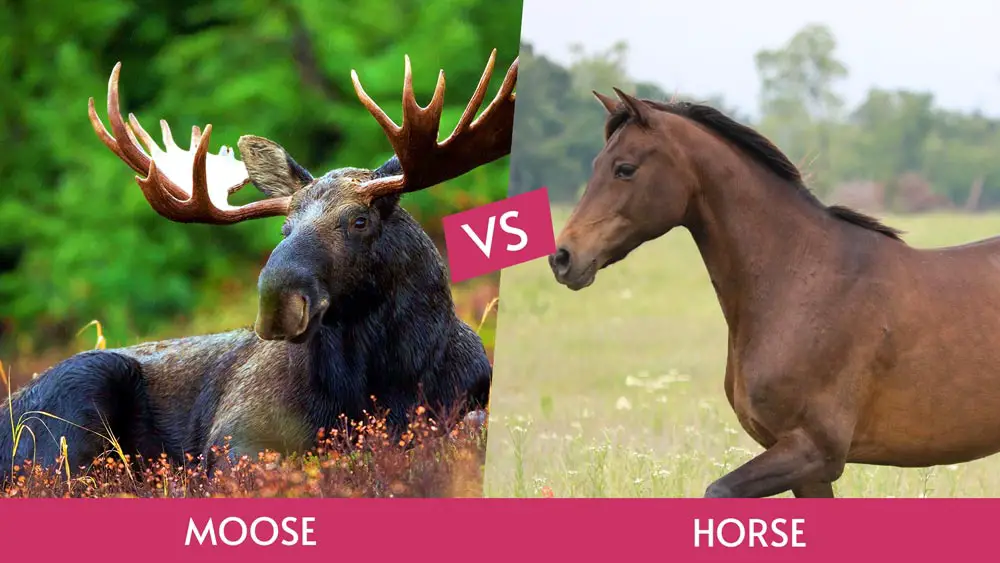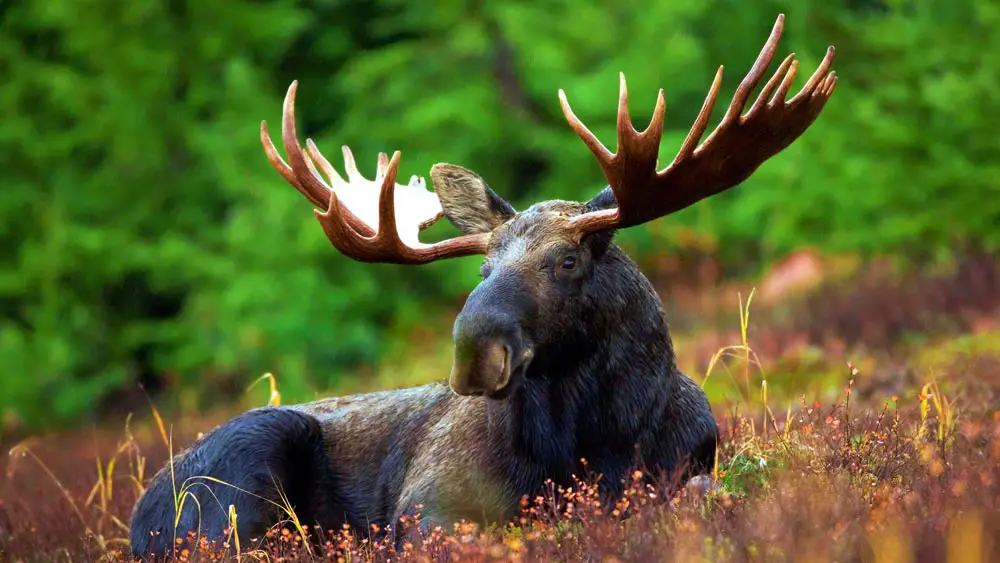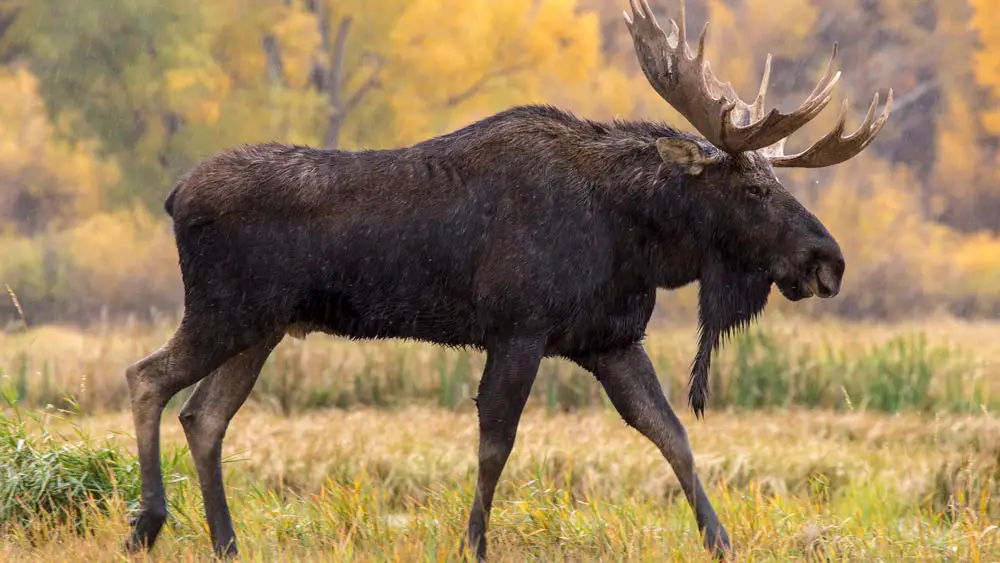Skip To Section

While moose and horses are both considered ungulates or hooved mammals, they are very different in appearance, characteristics, and life history.
Moose sport antlers, are taller than horses, and are strictly wild animals. While horses are faster and heavier than moose, can be domesticated or wild, and typically live longer than moose.
In this ultimate guide to moose and horses, we will provide you with the differences between the two animals including appearance, height, weight, speed, lifespan, habitat, human uses, and life history.
We will also answer some commonly asked questions regarding comparisons between moose and horses.
What Is A Moose?

Moose, scientifically known as Alces alces, is part of the deer family, making up the largest members. They can be found throughout Canada and the northern United States, being restricted to colder climates due to their insulated fur and large size.
They are herbivores, eating mostly parts of trees as their tall nature makes it hard for them to consume grasses and low-lying shrubs. Moose prefer the leaves of birch, willow, and poplar trees but will eat almost any plant material they encounter.
They are great swimmers and sport very powerful muscular bodies which are useful in defending themselves and their young against predators.
Wolves and bears are their prominent predators, but they are also vulnerable to parasitic brain worms carried by white-tailed deer.
What Is A Horse?

Horses, scientifically known as Equus caballus, are also ungulates, or hooved mammals, like moose. There are both wild and domesticated horses with over 400 different breeds making up just one species.
Domesticated horses can be found on every continent and in most countries, while wild horses are more commonly distributed in the western United States, western Europe, and Australia, with fewer populations in South America, southern Africa, and Middle Asia.
Like moose, horses are herbivores, but their diet mainly consists of grasses and hay. In the case of domesticated animals, some horse owners will supplement their horse’s diet with fruit or vegetables to provide necessary vitamins lacking in such grazed material as grass.
A horse’s natural predators are similar to moose due to their large nature and include bears, wolves, mountain lions, and coyotes. Whether adapted as a defensive mechanism or simply a function of their large size, horses actually sleep standing up instead of lying down on the ground.
Key Differences In Appearance Between A Moose And A Horse?
The most striking difference in appearance between a moose and a horse is the presence of a moose’s great antlers and the lack of antlers on a horse.
Instead, horses sport beautiful manes of hair that run from the top of their heads down their neck.

Moose are monochromatic, only appearing in subtle shades of brown. Horses can come in a variety of colors including brown, reddish-brown, black, white, tan, and mottled patterns.

Horses have long necks and faces, while moose have shorter necks. A moose’s hooves are cloven, separated into two “toes,” while a horse’s hooves are one oval-shaped unit.
What Is The Difference In Height Between A Moose And A Horse?
Moose are easily the taller of the two animals with an average height of six feet tall, although some moose can reach almost eight feet in height.
The tallest moose on record was found in the Yukon measuring over seven and a half feet tall. Typically, male moose are slightly taller than female moose, however, this may be accounted for by the height of their antlers.
Horses, on the other hand, vary in height depending upon the breed but most of them top out around five feet.
Clydesdales, one of the tallest breeds of horse in the world, can reach almost five and three-quarters feet tall – still falling just shy of the average moose height.
What Is The Difference In Weight Between A Moose And A Horse?
Despite being taller than horses, moose on average are generally lighter than horses.
A female moose usually weighs between 600 and 900 pounds, while a male moose can weigh between 800 and 1400 pounds.
Horses vary in weight depending upon the breed but most of them are at least 800 pounds and can weigh as much as 2000 pounds in the case of the Clydesdale. Given this, there are moose that can weigh up to 2000 pounds as well, but the average moose will be at least 500 pounds than that.
What Is The Difference In Speed Between A Moose And A Horse?
On average, moose and horses run at a similar speed – usually around thirty miles per hour. While moose top out around thirty-five miles per hour, some horse breeds can easily run at fifty miles an hour.
Some of the fastest horse breeds which can attain these top speeds include American Miniature horses, Appaloosas, Arabians, Thoroughbreds, American Quarter horses, Standardbreds, Andalusians, and Akhal-Tekes.
What Is The Difference In Lifespan Between A Moose And A Horse?
Moose and horses have similar lifespans, although horses tend to live a bit longer than moose.
Most horses, especially domesticated ones, have a lifespan of approximately 30 years, while moose usually live to be about twenty-five years old.
Since all moose are wild, they are more susceptible to predators and disease whereas domesticated horses, if properly cared for, are protected from predators and disease by their human owners who provide shelter, access to medicine, and a controlled healthy diet.
What Is The Difference In Habitat Between A Moose And A Horse?
Moose prefer colder environments and usually live in forests near bodies of water such as streams, ponds, and lakes. While some horses can also live in colder climates, they can also be found in warmer temperature environments, even deserts, and sandy beaches.
Wild horses especially live in extreme environments such as grasslands, deserts, prairies, badlands, and semi-arid plains. These habitats do not typically provide good sources of water year-round, so many wild horses are nomadic and roam to where food and water are available.
Domesticated horses can live almost anywhere as humans have the ability to build appropriately conditioned shelters to account for any harsh environmental conditions and temperatures.
In What Ways Are Moose And Horses Used By Humans?
Moose are popular to hunt for their meat and their pelts. While not currently used as domesticated animals, moose used to be trained to pull sleighs of royal couriers in Sweden hundreds of years ago.
Some reports claim that King Charles XI attempted to have moose trained for battle in a cavalry in the 17th century; however, that did not fare well as the moose were too skittish around gunfire. While it can be done, it is not recommended to attempt to ride a moose given these animals are not easily domesticated and should be left alone as wild animals.
Horses, on the other hand, have been domesticated for more than 5000 years. Their friendly nature aids in their trainability and over the centuries they have been used for multiple purposes.
Horses were trained to pull chariots and wagons as transportation for people and goods as far back as 2000 – 3000 B.C. They have been used in racing from chariot racing days all the way up to modern horse racing.
Horses are also used as work animals on farms to help pull plows and heavy loads of hay. Some horses are just for show and are ridden in competitions that involve show jumping, dressage, and vaulting. Another popular sport that uses horses is horse polo, in which riders play a team sport in the attempt to score more goals than the other team while riding horseback.
What Is The Life History Of Moose?
A newborn moose is called a calf and stays with its mother for about a year. After a year, the calf enters adolescence and separates from its mother to live alone. At about four to six years old, moose reach sexual maturity.
Male moose, also known as bulls, grow antlers in the spring so that by autumn they have a full rack to impress females and compete with other males for mating privileges. Female moose, also known as cows, mate with males in the fall and gestate for about seven to eight months before giving birth in the spring.
Female moose typically give birth every year and can sometimes even carry twins or triplets (though triplets are rare). Given the lifespan of a moose is usually about twenty to twenty-five years old, a female can have at least fifteen to twenty calves, if not more, over the course of her life.
What Is The Life History Of Horses?
Baby horses are called foals and stay by their mother’s side for at least the first two months while it’s still nursing. The young horse becomes a weanling around three months when it starts to eat solid food, and then a yearling from the ages of one to two years old.
At age two or three years old, horses reach adolescence. At this point, their growth starts to slow down. Males are known as colts and females are known as fillies. By the age of four, most horses have reached maturity and can be considered adults. Adult male horses are referred to as geldings or stallions and females are referred to as mares.
At this age, they can start breeding. Female horses gestate for about eleven months before giving birth and usually have, on average, sixteen babies throughout the course of their life.

FAQS
Is A Moose Stronger Than A Horse?
While moose stand taller than horses and look like they would be the stronger of the two, horses actually win in that contest.
Horses tend to be heavier and have more musculature. Horses also possess more agility and stamina. Overall, this makes horses much stronger when it comes to various tasks such as pulling heavy loads or even fighting for survival.
Can A Moose Outrun A Horse?
While moose and horses typically display a similar running speed of thirty miles per hour, certain horse breeds can run far faster than moose at top speeds of fifty miles per hour.
Other horse breeds are also faster in short bursts. If you put a moose and a horse in a racing contest, you’re almost guaranteed that the horse will win every time.
What’s Faster: Moose Or Horse?
At top speeds of fifty miles per hour, horses are definitely faster than moose. Some of the breeds that can reach these speeds include American Quarter horses, American Miniature horses, Appaloosas, Andalusians, Thoroughbreds, and Standardbreds.
Will A Moose Hurt A Horse?
Moose can be aggressive towards horses if they feel they are encroaching on their territory and especially if they perceive them as a threat toward their young. If a human approaches a moose riding on a horse, especially if accompanied by dogs, moose will hold their ground and may even attack as wolves are some of the moose’s natural predators.
Moose will charge at a horse and may even do some serious damage with their antlers if they catch the horse unaware, despite a horse being stronger and more muscular. Moose are taller and may have an advantage, especially if defending their calves.
How Tall Is A Moose Compared To A Horse?
A moose is typically taller than a horse. The average moose stands about one foot taller than the tallest horses. On average a moose is six to eight feet tall while a Clydesdale horse measures just shy of six feet. Most other horse breeds average around five feet tall, with some falling below that measurement and others slightly above.
Which Is Bigger On Average: Moose Or Horse?
Moose are taller than horses, typically standing at six to eight feet tall while most horse breeds only average a height of five feet tall.
On the other hand, horses typically weigh more than moose with moose weight ranging from 600 to 1400 pounds and horse weight ranging from 800 to 2000 pounds.
Some moose can also reach 2000 pounds but the average moose weighs around 800 or 900 pounds while the average horse weighs around 900 to 1000 pounds.
Male Alaskan moose are the largest moose in existence, typically measuring seven feet tall and weighing almost 1500 pounds. While the largest horse breed is the Clydesdale, measuring almost six feet tall and weighing upwards of 2000 pounds.
Are Moose And Horses Related?
While both moose and horses are ungulates or hooved animals, the highest relation they share on the taxonomic hierarchy is that of the class of mammals. Moose belong to the deer family which includes caribou, elk, and deer, while horses belong to the equine animals which include zebras and donkeys.
Can Moose And Horses Mate?
Male moose bulls have been seen to mate with female horse mares, but no progeny has ever been confirmed.
There have been a few instances of alleged horse-moose hybrid calves in Canada and Maine, but none of these have been confirmed through genetic testing. The mere speculation is due to the observation of abnormal traits for horses that appear to be due to moose parentage.
Do Horses And Moose Get Along?
Horses and moose are typically not compatible with each other. Moose are wild animals that are not successfully domesticated and as such will display aggression especially toward any animal they may perceive as a threat to their territory or young.
A moose attack is a serious threat to the life of any animal as it can do a lot of damage especially a full-grown male with antlers.
Horses are friendly by nature but should be paired with another domestic animal to avoid any fights and potential harm to either animal.
Conclusion
Moose and horses are two completely different species of hooved mammals that have some similarities including their strict diet of plants and mammalian traits but overall display notable differences especially in appearance, characteristics, and life history.
Moose have cloven hooves and the males display antlers. They also stand taller than horses at an average of six to eight feet high. They occupy cold climates in northern North America and live to be approximately twenty to twenty-five years old. They are wild animals that are not good candidates for domestication.
Horses have oval hooves and manes of hair down their necks. They typically weigh more than moose at weights upwards of 1000 to 2000 pounds. Horses are also faster than moose, attaining top speeds of fifty miles per hour compared to a moose’s thirty-five miles per hour.
Wild horses typically live in warmer, harsh environments like deserts and grasslands, while domesticated horses can live anywhere provided their owners build appropriate shelters. Horses can be domesticated and provide useful in sports competitions, in pulling heavy loads, and as transportation.
Overall, both of these animals provide unique advantages to their environments and should be treated respectfully according to their individual natures. Next time you come across a moose, don’t mistake it for a horse and vice versa!
